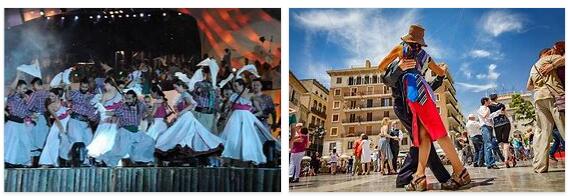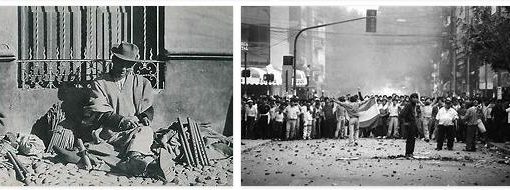The typography. – The first known book printed in the Rio della Plata region was a Roman Martyrology published in 1700 by the Jesuit Missions. However, this book has not been found, and the oldest known is that of Nieremberg, De la differencia entre lo temporal y eterno, published in 1705 by the same missions, which had a printing house, for which they availed themselves of the work of the Indians: it worked with characters of tin and wood engravings. Nieremberg’s work contains many illustrations that are impeccable for time and place. After having published some other books, among which there were also in Guaranì, the printing house was suppressed in 1729-30 for having reprinted a Letter on certain incidents in Paraguay.
Later the Jesuits set up another printing house in Córdoba (1766), which, however, managed to print few books, since the expulsion of the Jesuits removed the only people who knew how to make it work. Viceroy Vértiz transported her to Buenos Aires, where in 1780 she resumed work in the dependency of the Casa dei Trovatelli. In addition to serving for the printed documents needed by the administration, it published books mostly of religious subject, some speeches, administrative provisions and, in the century. XIX, some periodicals, as will be seen later. José Toribio Medina has listed in his valuable Historia y bibliografía de la imprenta en el Río de la Plata almost all the books published up to 1810: there are 851 issues. Starting from this date, we start actively printing. In 1816 the El Sol printing house was founded and a little later that of Gandarillas ; and before 1860 all the provinces had their own printers. For Argentina culture and traditions, please check calculatorinc.com.
the periodical press. – Leaving aside some handwritten Gacetas, which could not rise to the rank of periodicals, the birth of the Argentine press is marked by the appearance of the Télegrafo mercantil, rural, political – economic and historiógrafo del Río de la Plata in 1801; it was a biweekly, mostly eight pages, a little less than half the size of this Encyclopedia. This was followed by the Semanario de Agricultura, Industria y Comercio (1802-1806), the Correo del Comercio, founded by Manuel Belgrano in 1810 and the Gaceta de Buenos Aires (1810-1821), organ of the revolutionary government, founded by Mariano Moreno, who was its first director. It constitutes a source of great value for Argentine history, and was reprinted in 1910 by the Junta de Historia y Numismatica Americana.
From 1810 onwards many newspapers came out, for the most part ephemeral: El Argos and La Abeja Argentina, which were published during the intellectual renaissance aroused by Rivadavia, deserve a mention for their cultural purposes. At this time (1823) La Gaceta Mercantil began to be published, and then the Archivo Americano (1843-1851), which, under the direction of Don Pedro de Angelis, became the official newspapers of the Rosas dictatorship.
After the fall of this dictator, many newspapers appeared again, almost all of them short-lived. The oldest Argentine newspapers, which are still published today, are: The Standart, spokesman for the English colony, since 1861; La Prensa, 1869, and Los Debates (1857), which became in 1862 La Nación Argentina and in 1870 La Nación. In the capital, El Diario is also published, an evening newspaper, which has a certain influence on the higher social classes, spokesperson for the interests of Bonera; La Razón, the evening news paper, which deals with economic and financial matters with particular attention; Crítica, a liberal workers’ evening newspaper, with a large following in the popular classes; La Fronda, organ of the right-wing opposition, in the morning. The Italian colony has the Giornale d’Italia and L’Italia del popolo, and the other foreign colonies also have their own newspapers.
In the province they are notable for their age and importance: La Capital of Rosario, El Orden of Tucumán, La Voz del Interior and Los Principios of Córdoba, Los Andes of Mendoza, etc.
Among the popular magazines, the most widespread are: El Hogar (1915), Caras y Caretas, the oldest of the genre (1898), Atlantida and some others, in addition to the many, which continually appear and disappear.
The oldest of the scientific journals are: La Revista Farmacéutica, founded in 1858, organ of the Pharmacy Society, and La Revista de Educación, founded by Sarmiento in 1859, organ of the Directorate of Schools of the province of Buenos Aires.
The 1914 census records 520 periodic publications throughout the republic, including 493 in Spanish, 4 in Italian, 5 in English, 2 in French, 5 in German, 1 in Danish and 3 in Arabic.
The Argentine periodical press prior to 1852 was studied by Antonio Zinny in his works: Efemeridografía argirometropolitan, Efemeridografía argiroparquiótica, La Gaceta de Buenos Aires and La Gaceta Mercantil.
For the later one, one can consult the Anuario di Navarro Viola (1895). that of Francisco Antonio Le Rose and the news of the censuses of 1895 and 1914.




